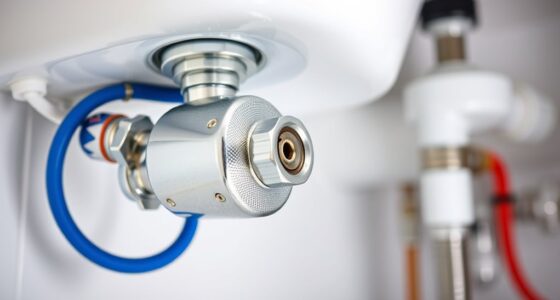Your automatic pool cleaner should be replaced when it shows signs of declining performance, frequent repairs, or noticeable wear and tear. If it struggles to clean properly, makes strange noises, or gets stuck often, it’s time for a new one. Battery issues, outdated technology, or persistent malfunctions also signal the need for an upgrade. Staying aware of these signs can save you time and money—keep going to learn more about when and why to replace your cleaner.
Key Takeaways
- Declining cleaning performance or mechanical issues despite troubleshooting indicate it’s time for a replacement.
- Frequent repairs or costly maintenance suggest your cleaner has reached the end of its lifespan.
- Battery problems, navigation failures, or parts getting repeatedly stuck signal the need for a new device.
- Unusual noises, vibrations, or outdated technology reduce efficiency and warrant replacement.
- Extensive damage, hardware failure, or persistent operational issues make upgrading to a newer model the best option.
Decline in Cleaning Performance

Over time, you may notice your pool cleaner isn’t picking up debris as effectively as it used to. This decline in cleaning performance can stem from sensor malfunction, which confuses the cleaner’s navigation and reduces efficiency. Additionally, filter clogging is a common culprit; when filters become blocked with dirt and debris, water flow decreases, limiting the cleaner’s ability to pick up debris properly. Regularly inspecting sensors and cleaning or replacing filters can often restore performance. If the filters or sensors are in good condition, it could indicate that the overall device lifespan is nearing its end. Addressing sensor issues and filter problems early can help maintain ideal cleaning, but persistent decline indicates it’s time to think about replacing your device.
Frequent or Costly Repairs
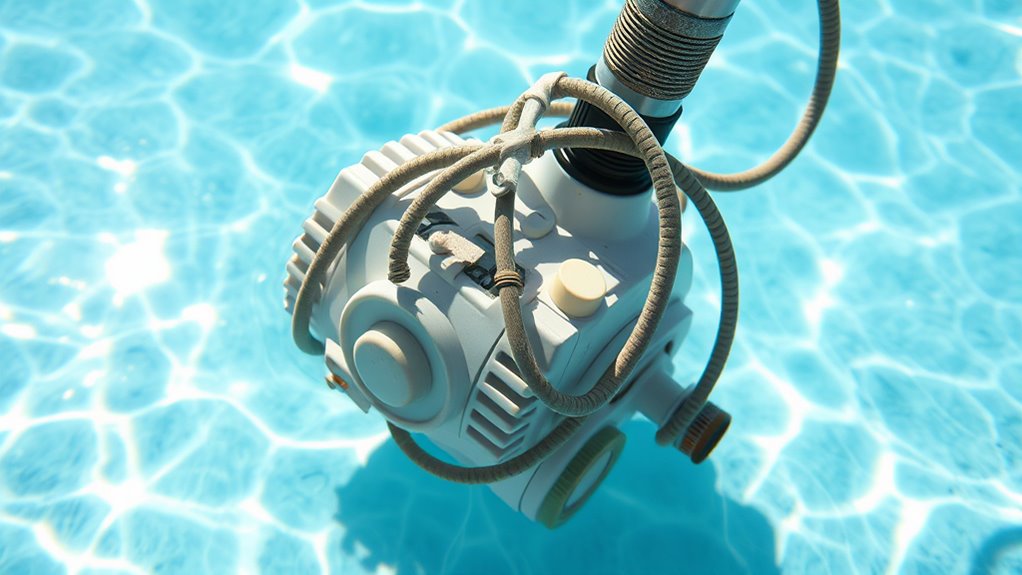
When your pool cleaner requires frequent repairs or the costs to fix it start to add up, it’s a clear sign that it may be time to replace the device. If you’re comparing automatic versus manual cleaners, consider that frequent repairs often indicate the device isn’t cost-effective anymore. Different pool cleaner types, such as robotic, suction-side, or pressure-side, can vary in repair frequency and expenses. Automatic cleaners tend to be more complex, which can lead to higher repair costs over time, especially if parts break down repeatedly. If you find yourself constantly fixing your cleaner or facing expensive repairs, it’s probably more practical to invest in a new one instead of repairing an old, unreliable model. This way, you ensure your pool stays clean without ongoing frustrations or costs. Recognizing patterns of behavior in the performance of your pool cleaner can help you determine when a replacement is truly necessary. Additionally, understanding the complexity of automatic cleaners can help you decide if repairs are worth the effort or if replacement is more economical. Regular maintenance and inspecting the brand reputation of your cleaner can also provide insights into its durability and expected lifespan. Moreover, being aware of wear and tear signs can guide you in making timely replacement decisions, especially considering that more advanced models may incorporate features from Mazda Tuning to improve durability and performance.
Excessive Wear and Tear
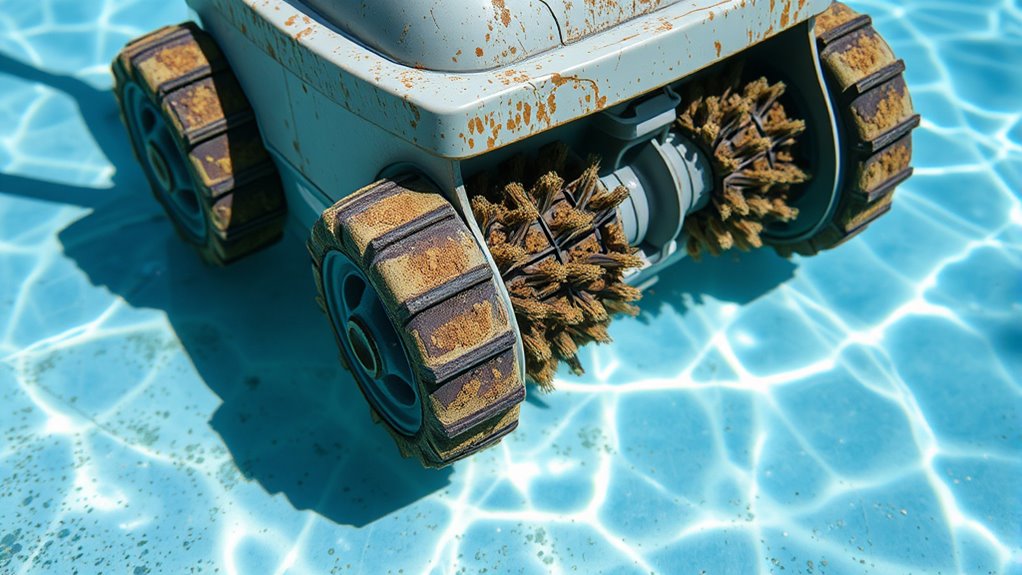
If your pool cleaner shows visible damage, like cracks or frayed parts, it’s a sign it’s wearing out. You might also notice it cleaning less effectively or hear strange noises during operation. These indicators suggest it’s time to contemplate replacing your cleaner before more issues arise. Regular maintenance can also help extend its lifespan and ensure optimal performance. Additionally, understanding heat pump technology can help prevent damage caused by improper handling and prolong the life of your equipment. Proper handling and device maintenance are essential for maximizing longevity and avoiding unnecessary replacements.
Visible Damage Indicators
Visible damage is a clear sign that your pool cleaner may be nearing the end of its lifespan. Look for visual damage like cracks, tears, or broken parts on the body or brushes. Corrosion signs, such as rust spots or discoloration, also indicate deterioration. These issues compromise the cleaner’s efficiency and can lead to further damage if ignored. Check the hoses and wheels regularly for signs of excessive wear or corrosion. If you notice significant visual damage or corrosion signs, it’s time to contemplate replacing your cleaner. Continuing to use a damaged device can result in poor cleaning, increased energy use, or complete failure. Addressing damage early helps you avoid more costly repairs and ensures your pool stays clean. Regular inspections and understanding wear and tear can help extend the lifespan of your equipment.
Declining Cleaning Performance
Over time, even the most well-maintained pool cleaners can show signs of wear that affect their performance. If you notice that your cleaner isn’t picking up debris as effectively or is leaving dirt behind, it may be due to excessive wear and tear. Poor pool chemical balance can also cause parts to corrode or degrade faster, impacting cleaning efficiency. Regular filter maintenance is essential; a clogged or dirty filter can strain the cleaner’s motor, reducing its ability to move properly. When cleaning performance declines despite proper chemical levels and filter upkeep, it’s a sign that your cleaner’s components might be worn out. Additionally, wear and tear on moving parts can lead to decreased efficiency. Understanding the technology behind automatic pool cleaners can help you identify when components are no longer functioning optimally. For example, some models use Glycolic Acid to maintain optimal performance and extend lifespan. At this point, replacing the unit ensures you maintain a clean, healthy pool without overworking your equipment.
Unusual Noises During Operation
Unusual noises during your pool cleaner’s operation often indicate that parts are wearing out or misaligned. Noise diagnosis can help identify specific issues early. Consider these repair considerations:
- Check the brushes and wheels for signs of excessive wear or debris, which can cause grinding or squealing sounds. Regular inspection of these components can prevent further damage and ensure smooth operation.
- Inspect the drive belt or gears for damage or looseness, as worn components often produce rattling or slipping noises.
- Examine the motor and impeller for obstructions or damage, which may lead to high-pitched whining or grinding sounds.
- Regularly inspecting wear and tear on key components can help prevent unexpected breakdowns and extend the lifespan of your cleaner. Staying vigilant about component condition is especially important for maintaining optimal performance and durability.
- Additionally, monitoring for signs of mechanical failure can help catch issues before they cause complete breakdowns, saving time and repair costs. Addressing these issues promptly can prevent further damage. Proper lubrication can also reduce mechanical noise and prolong component life, making maintenance more effective. If the noises persist despite repairs, it may be time to replace the cleaner altogether. Ignoring unusual sounds can lead to costly repairs and reduced cleaning efficiency. Furthermore, understanding the cost implications of repairs versus replacement can guide you in making the most economical decision.
Unusual Noises or Vibrations
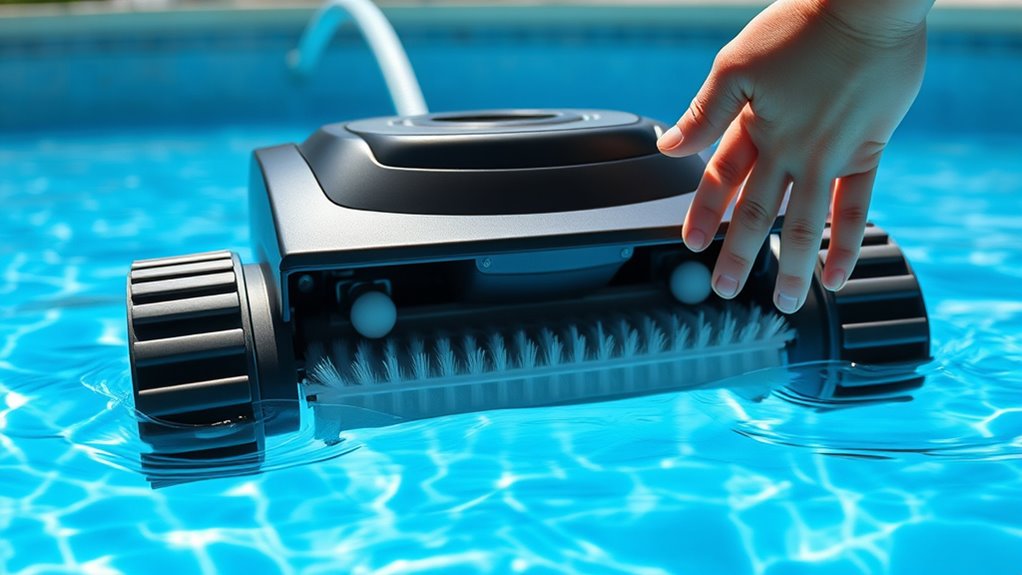
If your pool cleaner starts making strange noises or vibrating more than usual, it’s a clear sign something may be wrong. These unusual sounds often indicate worn or loose parts, which can lead to further damage if not addressed promptly. Regular maintenance routines help catch issues early and keep your cleaner running smoothly. Check for debris jammed in the brushes or wheels, and ensure all components are securely attached. If your cleaner is still under warranty coverage, consult the manufacturer before attempting repairs—this can save you money and prevent voiding the warranty. Ignoring these signs can lead to more extensive damage or complete failure, meaning you’ll need a replacement sooner rather than later. Addressing noise and vibration issues promptly extends your cleaner’s lifespan. Additionally, understanding the self-watering system in plant pots can remind you of the importance of timely maintenance to keep systems functioning properly.
Battery or Power Issues

Battery or power issues are common signs that your pool cleaner may need replacing. If you notice your cleaner’s battery life is shrinking or it stops mid-clean, it’s a red flag. Power fluctuations, where the cleaner turns on and off unexpectedly, also indicate trouble. Consider these key points:
- Shortened battery life that doesn’t improve with recharging
- Frequent power dips or surges causing inconsistent operation
- The cleaner fails to start or stops frequently during use
- Proper battery maintenance and understanding the power management system can extend the lifespan of your cleaner, but persistent issues often point to internal hardware failure. Additionally, internal hardware failure can lead to ongoing operational problems that are difficult to resolve through troubleshooting. Proper diagnostics and regular inspections can help identify issues early, but persistent battery or power issues can reduce cleaning efficiency and suggest the internal components are failing. If these problems persist despite troubleshooting, it’s time to think about replacing your pool cleaner to ensure consistent and effective cleaning.
Difficulty Navigating or Stuck

Have you noticed your pool cleaner struggling to navigate around obstacles or getting stuck in the same spot repeatedly? If so, it’s a clear sign that your cleaner may be malfunctioning. When this happens, you might find yourself resorting to manual cleaning more often, which defeats the purpose of automatic devices. Stuck cleaners often indicate worn-out wheels, damaged brushes, or clogged intakes—issues that might require replacement parts. If cleaning the brushes or replacing wheels doesn’t help, it’s likely time to contemplate replacing your cleaner altogether. Persistent navigation problems suggest your device has reached the end of its lifespan and can’t perform effectively anymore. Addressing these issues early can save you time and effort, but ultimately, replacement becomes the most practical solution.
Outdated Technology or Compatibility Problems
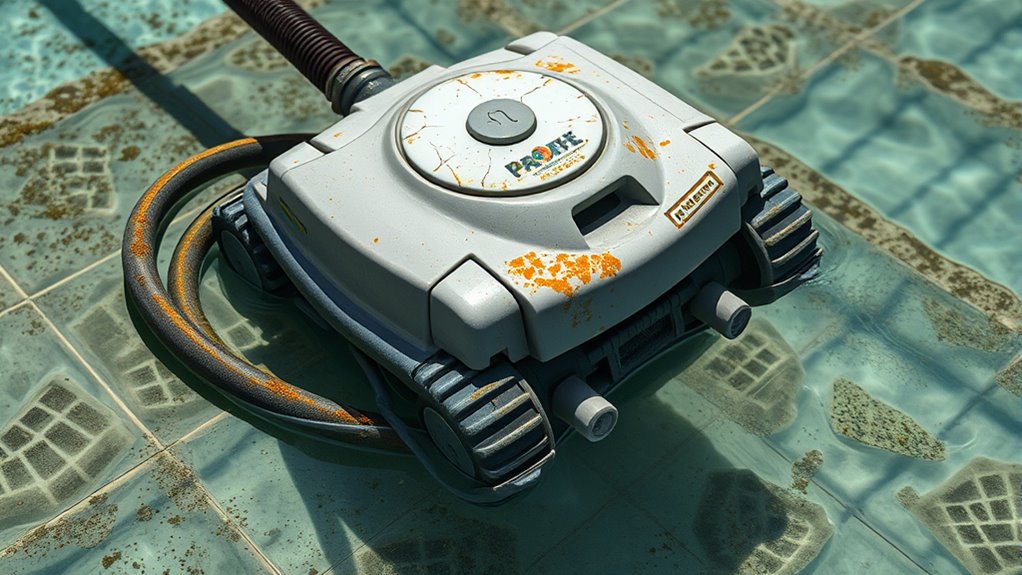
When your pool cleaner continues to struggle with navigation or gets stuck despite troubleshooting, it might be time to contemplate its technology. Technological obsolescence and compatibility concerns can hinder performance over time. If your cleaner is outdated, you may face issues like:
If your pool cleaner keeps getting stuck, it may be time to consider upgrading due to outdated technology.
- Incompatibility with newer pool systems or automation devices
- Lack of updated software or firmware for ideal operation
- Limited features compared to modern models, reducing efficiency
These problems can lead to poor cleaning coverage and increased maintenance. Recognizing when your device no longer meets current standards helps prevent frustration and costly repairs. Upgrading ensures you benefit from improved technology, better compatibility, and increased reliability. Staying current with advancements keeps your pool cleaner functioning smoothly and efficiently.
Frequently Asked Questions
How Long Should an Automatic Pool Cleaner Typically Last?
Your automatic pool cleaner usually lasts about 3 to 5 years, but this varies with usage and maintenance. Regular maintenance tips, like cleaning brushes and inspecting hoses, can extend its life. If you notice frequent repair costs or declining performance, it might be time to contemplate replacing it. Staying on top of maintenance helps you get the most out of your cleaner and avoid unnecessary expenses.
Are There Signs of Hidden Internal Damage Not Visible Externally?
You might wonder if there are signs of hidden internal damage in your pool cleaner. An internal inspection can reveal issues like cracks or worn parts that aren’t visible externally, helping you avoid unexpected breakdowns. Don’t assume everything looks fine outside—hidden damages can compromise performance. Regular checks make certain your cleaner runs smoothly and lasts longer, giving you peace of mind and saving money on premature replacements.
Can I Upgrade My Current Cleaner Instead of Replacing It?
You can definitely upgrade your current automatic pool cleaner instead of replacing it. Check repair options first; sometimes, a simple repair can extend its life. If you’re considering an upgrade, confirm upgrade compatibility with your existing system. Upgrading might include newer features or better efficiency, saving you money and hassle. Evaluate your cleaner’s age, performance, and repair costs to decide if an upgrade makes more sense than a full replacement.
What Is the Average Lifespan of Different Types of Pool Cleaners?
Think of your pool cleaner as a trusted friend—its lifespan varies by type. Robotic cleaners typically last 5-7 years, suction-side units about 3-5 years, and pressure-side models 4-6 years. To extend their life, follow maintenance tips like cleaning brushes and checking hoses regularly. When considering brand comparisons, choose reliable brands known for durability to get the most bang for your buck.
How Does Environmental Exposure Affect the Durability of My Cleaner?
Environmental exposure impacts your pool cleaner’s durability by causing chlorine corrosion and UV degradation. If your cleaner is constantly exposed to harsh sunlight, UV rays can weaken its materials, leading to cracks or breakdowns. Chlorine, common in pool water, accelerates corrosion, especially on metal parts. To prolong its life, regularly rinse your cleaner, store it in a shaded area, and check for signs of damage caused by these environmental factors.
Conclusion
If your pool cleaner shows signs like declining performance, costly repairs, or navigation issues, it’s time to replace it. Did you know that over 60% of pool owners experience decreased efficiency within three years? Upgrading ensures your cleaner works effectively, saving you time and money in the long run. Don’t wait until it’s completely broken—stay ahead of issues to keep your pool sparkling and maintenance simple.



